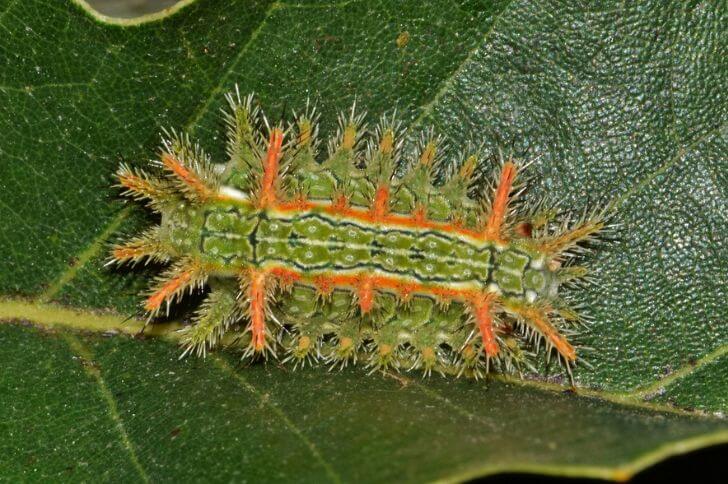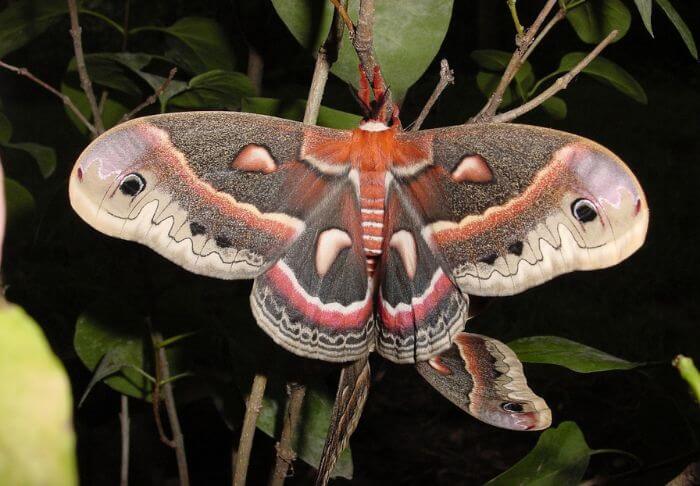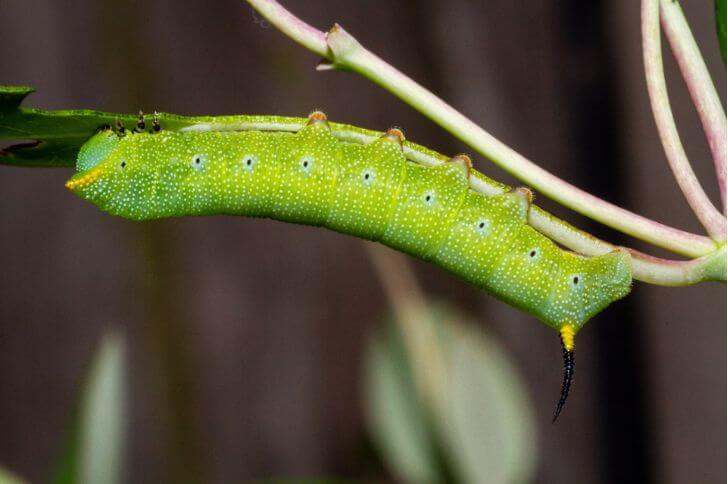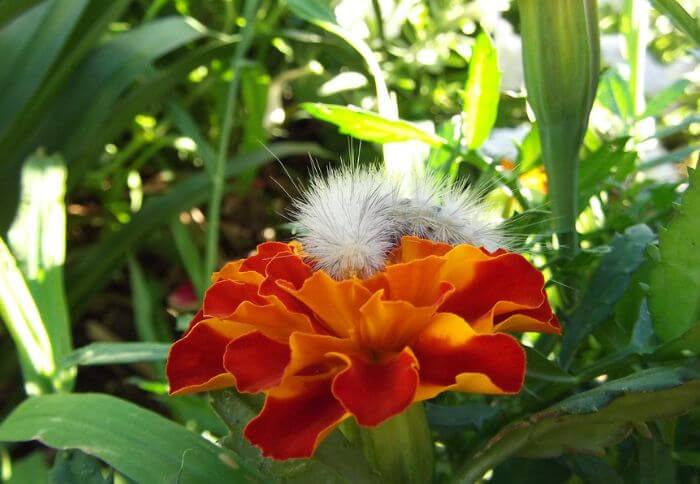Green Caterpillar in Texas (21 Species)
Texas is known for its rich biodiversity, and one fascinating aspect of this diverse state is the abundance of green caterpillars. These vibrant creatures, with their striking hues and unique patterns, can be found in various regions of Texas.
From the towering pine forests of East Texas to the arid deserts in the west, these green caterpillars have adapted to thrive in different habitats. Not only are they visually captivating, but they also play a crucial role in the ecosystem as important pollinators and food sources for other animals.
In this article, we will delve into the world of these enchanting insects and explore some of the intriguing types of green caterpillars that call Texas home.
Green Caterpillar in Texas (21 Species)
1. Regal Moth Caterpillar (Hickory Horned Devil)
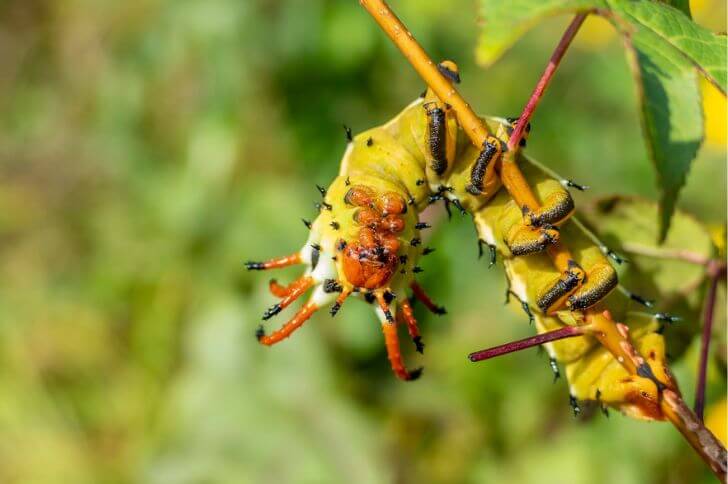
The fascinating world of insects never fails to surprise us with its quirky and mesmerizing creatures. One such captivating creature is the Citheronia regalis, colloqually called the regal moth.
Found in the Lone Star State of Texas, this moth has a striking green caterpillar called the hickory horned devil.
The sight of a hickory horned devil is truly a sight to behold. Its vibrant green color pops out against its surrounding foliage, making it almost impossible to miss. But what’s even more intriguing about this creature is its remarkable size.
Growing up to four inches long, it proudly boasts tiny black tubercles all over its body alongside mesmerizing orange spines that beguilingly shine like precious jewels just waiting to be discovered.
But it’s not just their appearance that makes them so captivating. The hickory horned devil caterpillar goes through several molts as it grows, shedding its skin multiple times before undergoing metamorphosis into an equally enchanting adult moth.
2. American Swallowtail (Papilio polyxenes)

As you stroll through the lush forests of Texas, a vibrant green creature catches your eye. It’s the caterpillar of Papilio polyxenes.
This stunning species is not only visually striking but also possesses fascinating characteristics that make it truly captivating.
One unique trait of the American swallowtail is its ability to mimic the appearance of toxic species like pipevine swallowtails. By imitating their coloration and patterns, this clever caterpillar tricks potential predators into thinking that it, too, is poisonous.
This impressive adaptation allows this Texas green caterpillar to avoid being eaten while peacefully munching on its favorite food sources – dill, fennel, and parsley.
Another intriguing aspect of this caterpillar’s life cycle is its reliance on specific host plants for survival. Female black swallowtail butterflies carefully select suitable host plants to lay their eggs on – usually members of the carrot family like Queen Anne’s lace or wild carrot.
Once hatched, these tiny green caterpillars begin feasting upon leaves with voracious appetites until they are ready to pupate into beautiful adult butterflies.
3. Old World Swallowtail Caterpillar (Papilio machaon)
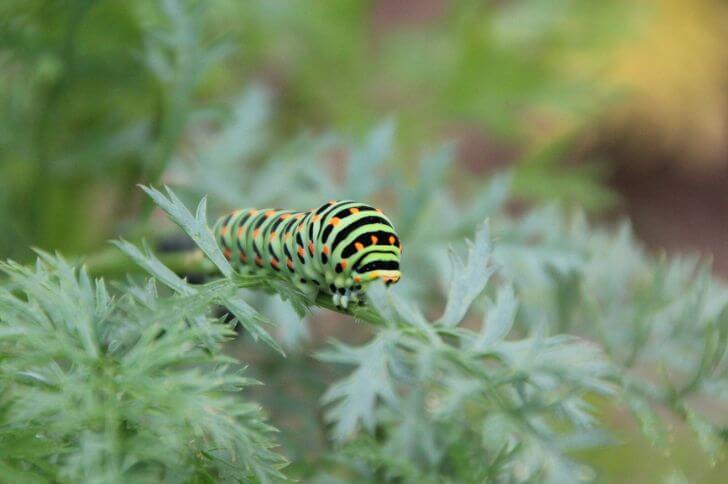
The Papilio machaon caterpillar, commonly known as the Swallowtail caterpillar, is a fascinating creature that can be found in the state of Texas.
With its vibrant green color and intricate patterns, it stands out among other caterpillars in the region. Not only is this caterpillar visually striking, but it also plays an important role in local ecosystems.
One interesting aspect of this green caterpillar in Texas is its feeding habits. While it primarily feeds on plants from the carrot family like fennel and parsley, it has also been observed consuming some poisonous species such as Poison Hemlock.
This behavior showcases the incredible adaptability of these creatures to different food sources while maintaining their own defenses against toxins.
4. Polyphemus Moth Caterpillar
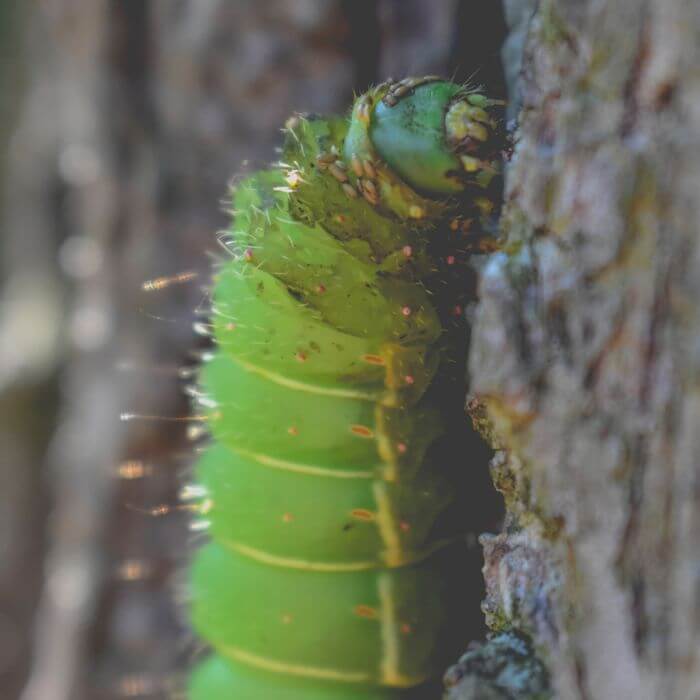
The Polyphemus Caterpillar is a fascinating creature that can be found in Texas and other parts of North America. Named after the mythical Cyclops from Greek mythology, this caterpillar has a distinctive appearance that is sure to capture your attention.
With its bright green body adorned with intricate patterns and small spiky protrusions, it truly stands out among its fellow caterpillars.
But what makes the Polyphemus Caterpillar truly unique is its ability to adapt and survive in different environments.
It has developed a clever defense mechanism by mimicking bird droppings when it feels threatened. This ingenious camouflage helps it blend seamlessly into the surroundings, making it difficult for predators to spot and attack.
5. Cloudless Sulphur Caterpillar (Phoebis sennae)
Commonly called the cloudless sulphur caterpillar, the phoebis sennae is a fascinating creature that can be found in various parts of Texas. Sporting a vibrant green color with subtle yellow stripes and black patterns, this caterpillar stands out among its peers.
What makes it truly captivating is its ability to undergo a remarkable transformation, emerging from an egg as a tiny larva and eventually transforming into a beautiful adult butterfly.
As it grows larger, the Phoebis sennae caterpillar becomes more voracious in its appetite. It feeds on the leaves of different plants such as cassias and partridge pea that are abundant in Texas gardens and meadows.
Despite its small size, this caterpillar has adaptations that enable it to protect itself from predators. The spines protruding from its body act both as camouflage and defense mechanisms against potential threats.
6. Glasswing Butterfly Caterpillar
The glasswing butterfly caterpillar is a mysterious creature that dwells in the dense forests of Texas. What sets it apart from other caterpillars is its intriguing ability to blend seamlessly into its surroundings, thanks to its semi-transparent appearance.
This unique trait not only serves as a clever defense mechanism against predators but also allows it to freely roam amidst leaves and branches without detection.
With every movement, the glasswing butterfly caterpillar seems to become one with nature itself. Its delicate body, adorned with subtle hues of green and brown, perfectly matches the foliage around it.
As if cloaked in invisibility, this extraordinary Texas insect foils the eyesight of birds and reptiles on constant hunt for their next meal. It’s truly a marvel of natural adaptation!
Related Read: Learn about Green Horned Caterpillars
7. Rosy Maple Moth Caterpillar (Dryocampa rubicunda)
Rosy Maple moths are one of the most fascinating green caterpillars of Texas. This vibrant green caterpillar stands out with its striking coloration and unique appearance.
It has a stout body covered in dense hairs that give it a fluffy texture, resembling small tufts of moss. The bright green color helps camouflage it among the leaves of the maple trees, where it feeds on their tender foliage.
One intriguing aspect about these caterpillars is their ability to change colors as they mature. While they start off with a predominantly green hue, they gradually develop pink and yellow patches along their bodies.
As they near adulthood, the bright hues become more prominent, providing effective warning signals to potential predators. These colors often deter birds from attacking them because they associate such vibrant hues with toxic or distasteful prey.
Aside from their enchanting appearance, one remarkable behavior displayed by the rosy maple moth caterpillar is its ability to create silk webs for shelter. Constructed high up in trees or underneath leaves and branches, these silken nests serve as protective encasements for transformation into cocoons.
Remarkably enough, despite their small size and relatively short lifespans as moths (only two to nine days), each one goes through several molts during its growth phase before reaching maturity.
8. Tulip-tree Beauty Caterpillar
One of the most intriguing and beautiful caterpillars you will find in Texas is the tulip-tree beauty caterpillar. This vibrant green larva is adorned with fine white speckles that resemble delicate jewelry, making it truly stand out among its fellow insects.
The mesmerizing patterns on its body are believed to serve as a form of camouflage, blending seamlessly with the leaves of the tulip tree (also known as the yellow poplar) on which it feasts.
What sets this particular caterpillar apart from others is not just its physical appearance but also its behavior. While most caterpillars tend to stay hidden during daylight hours, the tulip-tree beauty caterpillar can often be found basking openly in bright sunlight.
It seems unbothered by potential threats and embraces its environment fully, giving photographers and nature enthusiasts a rare opportunity to observe and capture its magnificence up close.
This boldness could be an indication of its confidence in relying on both its stunning appearance and the protection provided by its chosen host plant for survival.
9. Hummingbird Clearwing Caterpillar (Hemaris thysbe)
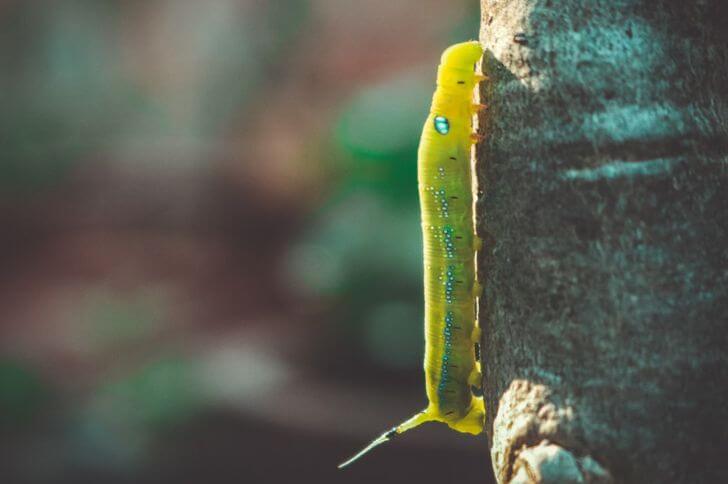
Another fascinating green caterpillar that favors the meadows of Texas is the hummingbird clearwing. What makes this caterpillar so intriguing is its uncanny resemblance to a bumblebee or even a tiny hummingbird.
With its plump body, transparent wings, and rapid movements, it successfully mimics these agile creatures with astonishing accuracy.
But there’s more to this Texas caterpillar than just its appearance. Its feeding habits are also quite unique and unexpected. Unlike other caterpillars that solely rely on leaves for nutrition, the Hemaris thysbe has a penchant for nectar-rich flowers.
It uses its long proboscis to drink from various plants such as honeysuckle and phlox. This behavior not only sets it apart from typical leaf-munching counterparts but also aids in pollination—a win-win situation both for itself and the plant species it frequents.
10. Blinded Sphinx Caterpillar (Paonias excaecatus)
With its striking coloration and distinct body markings, the blinded sphinx stands out among the many species in the region. One particularly intriguing feature of this caterpillar is its ability to camouflage itself perfectly within its surroundings by mimicking leaves and blending seamlessly into vegetation.
Another captivating aspect of the blinded sphinx caterpillar is its intriguing life cycle. After emerging from its egg, it begins to feed voraciously on various plant species, primarily trees like oak and hickory.
As it grows in size, so does its appetite, allowing it to consume large amounts of foliage within a short span of time. This rapid growth eventually leads to a transformation when it enters the pupal stage and undergoes metamorphosis into a beautiful adult moth.
11. Long-tailed Skipper Caterpillar
One unique species of caterpillar that can be spotted in the green landscapes of Texas is the long-tailed skipper caterpillar. Known for its vibrant green color and distinctive black head, this caterpillar has a captivating appearance that sets it apart from other species.
While many caterpillars are well-camouflaged to blend in with their surroundings, the long-tailed skipper caterpillar boldly displays its green hue as if daring anyone to challenge its presence.
But beyond its eye-catching appearance, the long-tailed skipper caterpillar boasts some interesting survival techniques.
It has been observed that when threatened, this caterpillar arches its body into an S-shape and thrashes itself back and forth. This behavior not only helps it scare away predators but also mimics a snake-like motion as a clever defense mechanism.
By imitating another feared creature in nature, the long-tailed skipper caterpillar effectively wards off potential threats without having to resort to dangerous toxins or spiky hairs like many other caterpillars do.
11. Tawny Emperor Caterpillar
The Tawny Emperor caterpillar is a fascinating creature that can be found in the warm and humid climate of Texas. Its vibrant green color makes it stand out among other caterpillars, making it easy to spot as it leisurely crawls along leaves and branches.
This green caterpillar in Texas has a unique trick up its sleeve – when alarmed or threatened, it will rear up and display two bright orange horns on its head, mimicking the appearance of a snake.
This protective behavior gives this large green Texas caterpillar a fighting chancel.
Also, while many caterpillars prefer to munch on specific plant species, this green caterpillar is not so picky. It will happily feed on a variety of plants including elm trees, hackberry trees, and nettle plants. This adaptability allows the Tawny Emperor to thrive in different environments where these plants are abundant.
12. Gray Hairstreak Caterpillar
The Gray Hairstreak Caterpillar, often overlooked amidst the kaleidoscope of colorful green caterpillars in Texas, is a fascinating creature brimming with hidden secrets. Its unassuming appearance may deceive you into thinking it’s just another average green caterpillar, but upon closer inspection, its true uniqueness begins to emerge.
Sporting a blend of gray and green hues, this caterpillar boasts an intricate pattern along its body that mimics the texture of bark, providing an exceptional camouflage against predators.
Another intriguing aspect of the gray hairstreak caterpillar is its incredible ability to undergo deceptive transformations.
As it grows and develops within its chrysalis, this seemingly ordinary caterpillar undergoes a spectacular metamorphosis that transforms it into a strikingly beautiful butterfly with delicate gray wings adorned with vibrant orange markings. It’s truly astonishing how such subtle shades can give rise to such exquisite allure.
13. Statira Sulphur Caterpillar
Statira Sulphur caterpillars are striking insects found throughout the state of Texas. They belong to the family Pieridae and get their name from their vibrant green coloration.
This eye-catching caterpillar has become a favorite among nature enthusiasts due to its charismatic appearance and intriguing lifecycle.
One interesting aspect of Statira Sulphur Caterpillars is their feeding behavior. They primarily consume legumes, including various species of clover and alfalfa.
This diet contributes to their bright coloring since some compounds in legumes are transformed into pigments stored in their bodies. Interestingly, studies have shown that these pigments can act as chemical deterrents against potential predators by making the caterpillars distasteful or toxic.
14. Florida Fern Caterpillar (Callopistria floridensis)
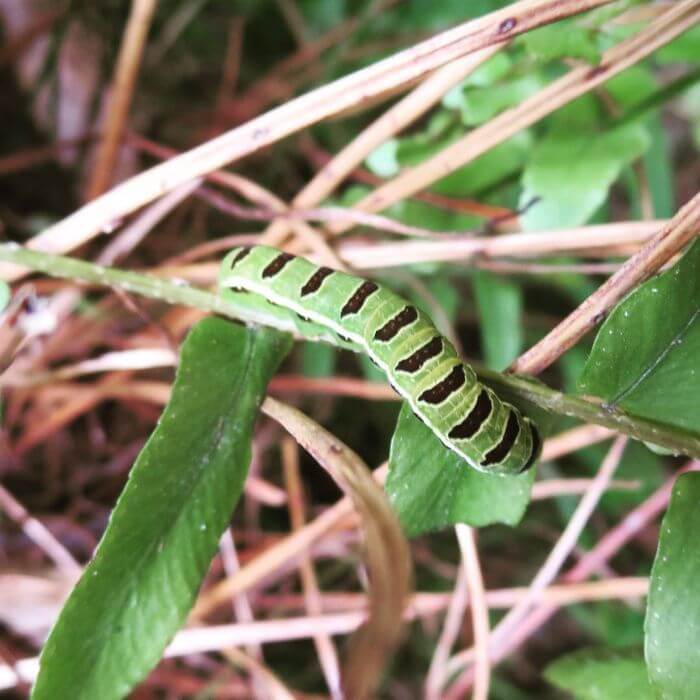
source: cottagenest
With its eye-catching green coloration and thin, short body, the Florida fern caterpillar is another insect that stands out amongst other caterpillars in the region.
One interesting fact about this green Texas caterpillar is its diet. It primarily feeds on plants belonging to the family Asteraceae, which includes sunflowers and daisies. This food source not only sustains the caterpillar during its growth stages but also contributes to its vibrant green hue. It’s astonishing how nature has designed these creatures to blend in perfectly with their environment.
15. Spicebush Swallowtail Caterpillar (Papilio troilus)
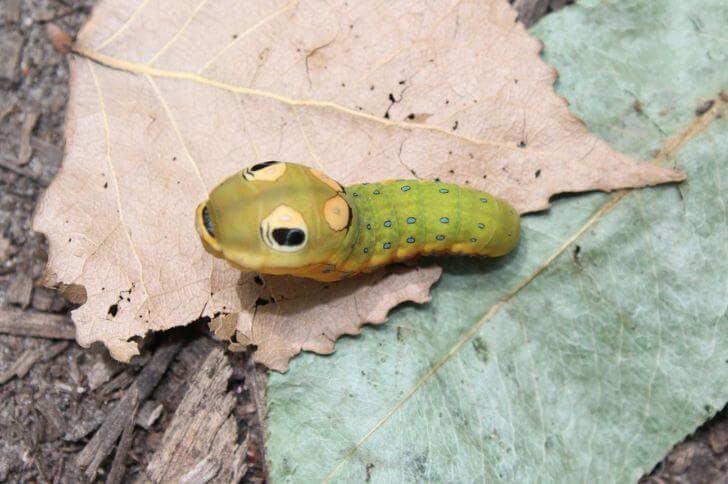
With its bright green body and distinctive false eyes on its head, the spicebush swallowtail caterpillar stands out amidst the foliage it calls home.
But beyond its visual appeal, this species holds an intriguing secret – it possesses a unique defense mechanism that sets it apart from other caterpillars.
When threatened by predators such as birds or lizards, the Papilio troilus caterpillar displays an astonishing act of deception. It retracts its head into its thorax and presents two large eye patches on its abdomen, mimicking the appearance of a snake’s face.
This clever tactic startles potential attackers, giving the caterpillar time to escape unharmed. This adaptation showcases nature’s incredible ability to evolve and adapt to survive in challenging environments.
16. Elm Sphinx Caterpillar (Ceratomia amyntor)

source: rdpjart
The Elm Sphinx Caterpillar, scientifically called ceratomia amyntor, is a remarkable creature that never fails to intrigue nature enthusiasts. Found primarily in the eastern regions of North America including Texas, this striking caterpillar is known for its vibrant green color and unusual horn-like protrusion on its rear end.
As it moves gracefully across branches and leaves, it leaves behind not only a trail of wonder but also a trail of destruction.
Despite its delicate appearance, this Texas caterpillar can be quite voracious in its appetite. It feeds on the foliage of various tree species, with elms being its preferred choice.
This peculiar food preference has lent itself to drawing attention from researchers who study the ecological impact of these caterpillars on elm populations. Their feeding habits have been found to significantly affect tree growth and even contribute to defoliation during peak population years.
17. Black Swallowtail Caterpillar
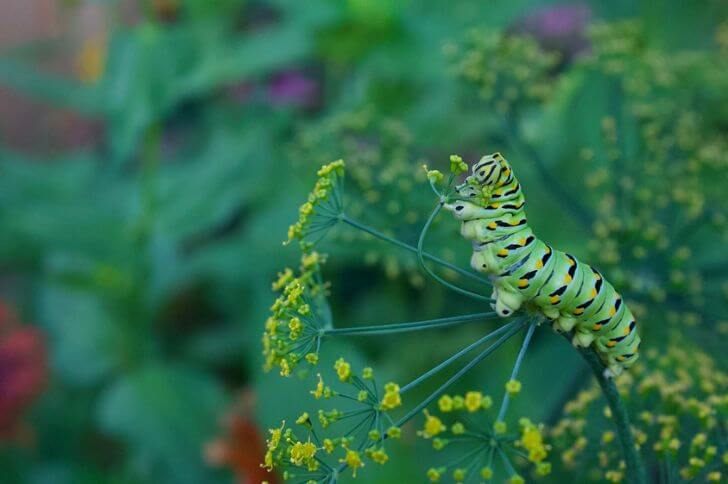
Known for its striking appearance and unique characteristics, the black swallowtail caterpillar has become a favorite among nature enthusiasts.
Sporting vibrant green hues with black and yellow markings, it is truly a sight to behold. What sets the black swallowtail caterpillar apart from other caterpillars is its ability to transform into a beautiful butterfly.
It undergoes a series of remarkable metamorphoses, starting as an egg and later turning into a pupa before finally emerging as an adult butterfly.
Another fascinating aspect of this caterpillar’s journey is its choice of food plants. While many other species have specific host plants, this green caterpillar of Texas is known to feed on various plant families such as carrot family (Apiaceae) and citrus family (Rutaceae).
This adaptability allows them to thrive in different habitats across Texas, from gardens to forests.
18. Green Cloverworm Caterpillar
The vibrant green of the green cloverworm caterpillar is truly a sight to behold. Found in abundance in Texas, these caterpillars are known for their unique ability to blend in with their surroundings, making it harder for predators to spot them.
Their coloration serves as excellent camouflage among the foliage of plants, providing them with not only a means of protection but also a source of sustenance.
Despite their small size, these caterpillars have voracious appetites and can quickly devour entire leaves, leaving behind only stems and veins.
While they may seem inconspicuous at first glance, green cloverworm caterpillars play an essential role in maintaining the balance of ecosystems.
These creatures act as natural pest controllers by feeding on various weeds and destructive plants like clover and alfalfa. Additionally, researchers have discovered that some species of birds rely heavily on these caterpillars as a food source during certain times of the year.
This interdependent relationship between birds and green cloverworm caterpillars underscores the crucial role they play in supporting local biodiversity.
19. Honey Locust Moth Caterpillar
The honey locust moth caterpillar is another fascinating green insect found in Texas. These vibrant green caterpillars are typically seen during the warmer months, feeding on the leaves of honey locust trees.
What makes them particularly intriguing is their unique defense mechanism – clusters of spiky bristles running along their bodies. While these bristles may look harmless, they can actually cause mild irritation if touched or brushed against.
Also ,once fully grown, it spins a silky cocoon that blends seamlessly with the surrounding foliage.
Inside this protective casing, magical changes occur as it undergoes metamorphosis to become an adult moth. This remarkable transformation demonstrates nature’s ability to continually surprise us with its intricate processes and adaptations.
Despite their defensive spines and vibrant colors, these green caterpillars play an essential role in ecosystems by acting as food sources for birds and other predators.
They serve as a reminder that even creatures we may deem insignificant or pests have important roles within larger ecological systems. Observing these caterpillars in action not only allows us to marvel at their beauty but also encourages us to appreciate the delicate balance of nature all around us.
20. Cecropia Moth Caterpillar

One of the most fascinating caterpillars you can find in Texas is the cecropia moth caterpillar. With its vibrant green color and distinctive spiky appearance, it stands out among other caterpillar species.
But what truly sets this creature apart is its size—the largest caterpillar in North America, with some individuals growing up to six inches long! Its large size and bright colors make it a delight to spot amidst leaves and branches.
The life cycle of this moth is equally intriguing. After hatching from tiny eggs laid on plants such as maples and cherry trees, these caterpillars begin their journey of growth.
They undergo a series of molts, shedding their old skin several times before reaching maturity. At each stage, they sport different patterns and markings that act as camouflage against predators. It’s almost like witnessing an enchanting transformation unfold right before your eyes.
Observing these creatures in nature can be quite an adventure. You might see them munching voraciously on leaves or inching along branches with surprising agility for their size.
And if you’re lucky enough to come across one during late spring or early summer, you may witness the miraculous pupation process where the caterpillar transforms into a cocoon and eventually emerges as a majestic cecropia moth—a breathtaking sight that reminds us just how magical nature truly is.
21. American Snout Caterpillar
The American Snout Caterpillar, a distinctive and captivating creature found in the state of Texas, is a sight to behold for nature lovers. With its vibrant green coloration and unique physical structure, this caterpillar stands out from the rest.
What sets it apart is its elongated snout-like projection which gives it an uncanny resemblance to a dead leaf. This clever camouflage not only helps protect the caterpillar from predators but also allows it to blend seamlessly into its surrounding environment.
While most caterpillars rely on their protective coloring or spines for defense, the American snout caterpillar takes a different approach by imitating inedible objects.
The snout projection acts as both an intimidation tactic and as a sensory organ. It plays an important role in helping the caterpillar sense its surroundings and even acts as a touch-sensitive appendage that allows it to navigate through foliage with ease.
Another fascinating aspect of this species is its adaptability to various ecosystems within Texas. Whether they are found among trees in forests or hidden within shrubs in grasslands, these versatile creatures thrive wherever vegetation is abundant.
It’s remarkable how such a small creature can survive and thrive across diverse landscapes while remaining inconspicuous due to their effective camouflage strategy.
Final Thoughts:
Texas is home to a variety of green caterpillars that play important roles in the ecosystem. From the prominent tomato hornworm to the elusive emerald moth caterpillar, these creatures showcase both diversity and adaptability.
Understanding the different types of green caterpillars in Texas can help gardeners and nature enthusiasts appreciate their presence and make informed decisions about conservation efforts.
By protecting their habitats and promoting sustainable gardening practices, we can ensure the continued survival of these fascinating creatures for future generations to enjoy. So let us embrace our green caterpillar friends and work together towards a greener and more vibrant Texas!
Source:
Passionate animal photographer with an unwavering love for capturing the essence and beauty of our furry friends.
With over five years of experience in the field, I have developed a unique ability to connect with animals on a deeper level, allowing me to create stunning and captivating images that truly reflect their personality.
Let’s collaborate to capture unforgettable moments that celebrate the unique bond between humans and animals!
